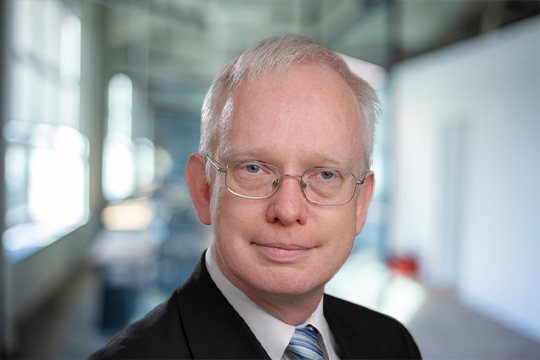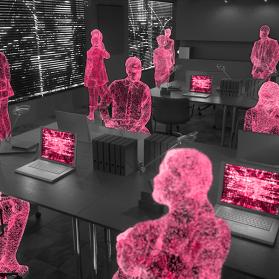The transfer of assets directly and securely from one user to another is the key feature of Web 3.0. Blockchain technology represents enormous leverage for innovation, especially for projects that target and improve financial flows. Björn Froese and Hans-Werner Hatting spoke about this subject with Dr. Karl-Michael Henneking, who as co-founder of the global distributed economy network Untitled INC actively promotes the use of blockchain technology. His message to all CFOs: “For the moment, you as the CFO might be able to sit out the digital assets issue for — perhaps — the next five years, but after that, things will start to become critical.”
Hans-Werner Hatting: What led you to Web 3?
I have been involved in the blockchain space since 2016. I came across blockchain through Initial Coin Offerings (ICOs). ICOs were and still are revolutionary in terms of corporate or start-up financing. I first heard about ICOs in 2016 at a conference in Berlin: A project raised $200 million on the spot, based solely on a white paper!
In 2016, together with other blockchain enthusiasts, I co-founded the expert network Untitled INC, through which we invest in Web 3.0 projects and build our own Web3 companies. We also help other players scale their projects and advise institutional clients such as banks and venture capitalists in the field of digital assets. Untitled INC is an international network of blockchain, Web 3.0, and digital asset experts distributed across all continents of the world.
At its core, Web 3.0 is about an "Internet of Value," which means how to transfer values on the internet directly and securely between users, not just content as in Web 2.0. Therefore, blockchain technology has a great innovative lever, particularly for projects focusing on financial flows and improving them.
This includes ICOs. With the Untitled INC subsidiary, Untitled Investment Expertise, we have also developed a framework called ICO360 to evaluate ICO projects. We use a combination of traditional venture capital criteria, as well as M&A and post-merger valuation criteria, and web3-specific criteria such as a project's tokenomics. This framework goes far beyond what is usually used by professional investors to evaluate Web3 projects.
Web 3.0 is becoming increasingly interesting for institutional investors in the financial industry, especially as the regulatory framework develops and becomes clearer, particularly in Europe. Banks and large fund managers, in particular, are being urged by their customers to offer investment products to benefit from the Web 3.0 movement.
Björn Froese: In Germany, one of the aspects that fueled the ICO boom was that existing company law did not include provisions governing employee holdings without voting rights in the company. Did that actually play a major role, and can a similar logic using tokens and enabling people to hold participating interests with exclusively financial returns be found in other countries?
Several things have come together in this sense. The Web 3 movement is less regulatory or legal; it is above all technology-driven, coupled with the ability to raise large volumes of funding like the aforementioned $200 million at one time. Obviously, there is also a lot of speculation involved. Moreover, the price development of crypto-assets has attracted media attention, which in turn has led to more and more people becoming interested in the technology. The legal aspects to which you are referring have not been the essential driver, in my opinion.
In the last two years, however, the topic of DAO, the decentralized autonomous organization, has been gaining international momentum. This is partly to prevent being subject to classic financial regulation as a centralized organization. The more a project decentralizes its governance, the higher it builds a certain regulatory firewall.
DAOs have a very specific form of governance. Strategic and key financial decisions are made by token investors. The operating team, on the other hand, consists — to put it simply — of freelancers or volunteer contributors who implement these decisions. In other words, the organization of DAOs differs from that of traditional companies.
Regulatory and legal issues have recently become increasingly important. The more institutional players from the finance industry enter the market, the more important regulation becomes. If a crypto-project lacks regulatory safeguards, compliance departments immediately shut it down.
Our interview partner: Dr. Karl-Michael Henneking
Dr. Karl-Michael Henneking is a co-founder of the globally operating Distributed Economy network Untitled INC and actively promotes the use of blockchain technology. His many and diverse activities are highlighted by his publications on innovation, digitalization, and digital transformation and by his role as an active investor and podcast host on Untitled Investment Talks.
Digital transformation in all its facets is his passion as is reflected in his many years of experience in leadership positions at senior management, management board, and supervisory board levels. He has effectively applied his expertise in strategy and innovation, leading major digital transformation projects, building up companies, venture capital and mergers & acquisitions in more than 30 countries around the globe.
In the course of his career, Dr. Henneking has built large telecommunications companies and fast-growing startups, and he was the founder of one of the first corporate VCs on the Arabian Peninsula. He is a Detecon alumnus where, before leaving the company, he was Head of the Global Competence Practice Strategy & Marketing.
Björn Froese: In Europe, we have the Markets in Crypto-assets Regulation, the MICAR. Is this the right way to build sufficient trust?
Yes, MiCAR is really a huge step with international ramifications as well. You wouldn’t necessarily expect that. But if you talk to corporate founders from America right now, you will often hear their recommendations to establish crypto-startups in Europe — not in America — as the regulatory situation has not been clarified sufficiently in the USA. There are various regulatory authorities in that country; besides the stock exchange regulators at the SEC (Securities and Exchange Commission), you have the CFTC (Commodity Futures Trading Commission) for futures transactions, and bank regulators, and in addition, each state has its own regulatory requirements. There is simply no standardized regulatory framework in the USA comparable to the one developed by the adoption of the MiCAR in Europe. Each authority applies its own standards, and many issues are unresolved or out of step with the times.
For example, following the critical developments concerning the FTX exchange, Voyager, and Terra Luna, Gary Gensler, SEC chairman, is currently practicing regulation through enforcement of case-by-case decisions by his agency, essentially driving projects and innovation out of the USA. This is starkly illuminated by the example of the recent lawsuits filed against the crypto-exchange Coinbase. Coinbase is a publicly traded company under SEC rules and carefully considers its activities to ensure regulatory compliance. The SEC, however — as media reports seem to indicate, at least — is behaving rather unprofessionally towards Coinbase in that it refuses for months to engage in a dialog on unanswered regulatory issues such as whether or not certain crypto-assets should be classified as securities, but then turns around and files a complaint against Coinbase concerning precisely these issues. And Coinbase is merely the tip of the iceberg.
Normally, the tech scene does not like regulation at all. But now they see the benefits: chaos in the US versus a harmonized regulatory framework developed in Europe over the past years, which covers large parts of the crypto space. The MiCA Regulation, which was passed by the EU Parliament earlier this year and is now being implemented in the member states, is proving to be a major asset for Europe as a business location.
And this is reflected in solid figures when you compare the USA and Europe: the share of global VC investments in crypto-projects in Europe was about 5 per cent in Q1/2022, but had increased to more than 45 per cent in Q1/2023, a factor of 10, and this growth has essentially come at the expense of the USA. There are nearly 4,000 crypto-companies in Europe, making Europe the world leader in corporate settlement. So MiCAR is obviously beneficial for the locations, even though not everyone in crypto-space necessarily has unqualified praise for MICAR.
MiCAR in its present form also does not regulate every single aspect and has left some issues such as DeFi (decentralized finance) instruments open; NFTs (non-fungible Tokens) are another gray area. But MiCAR is very clear in its regulation of stablecoins. The classic stablecoin market, i.e., tokens pegged to fiat currencies, still focuses primarily on the US dollar at the moment. MiCAR has now given institutional players opportunities to position themselves on the market using euro stablecoins, and this is certainly one of the great accomplishments of MiCAR.
Germany, by the way, forged ahead two years ago with a cryptocurrency custody regulation and a structured licensing process that is regarded as an international benchmark. Untitled Investment Expertise has published a good overview of this topic. These measures also represent a milestone and an area where startups benefit from a clear regulatory framework, and even the USA technology and VC sectors look enviously toward Europe.
Hans-Werner Hatting: Why should CFO concern themselves with a topic such as stablecoins?
In my opinion, there are several reasons why a CFO should be interested in the crypto space, and stablecoins can be one of them.
For instance, CFOs face the question of what to do with the treasury. In the short term: business as usual. From a long-term perspective, however, financial strategy issues arise. Inflation causes fiat currencies to lose value. Fiat currencies are also no longer tied to a gold standard; the Bretton Woods Agreement was revoked in 1971. To be sure, this is what made quantitative easing, i.e., the expansion of the money supply by central banks, possible in the first place.
Does it now make sense in the long term to hold significant cash positions? This is a good starting point to take a close look at cryptocurrencies from a CFO’s perspective! Michael Saylor and his company Micro Strategy in the USA, for example, have done exactly this. Micro Strategy has decided to invest significant portions of its treasury in Bitcoin, an investment that in the meantime has exceeded $4 billion. Elon Musk has followed suit to some extent at Tesla, and there are also quite a few financial institutions investing parts of their treasury in Bitcoin as a hedge against currency devaluation. This is certainly an enormous step and presumes a long-term planning horizon of five years or more.
However, there are also opportunities to profit from financial instruments based on digital assets in the short term. This is where stablecoins and other factors play a role when it comes to the payment of interest on treasury funds. Although it is true that the interest rate regime has changed (in recent months), only a year ago, we had zero interest rates or even negative interest rates in Europe while the DeFi sector was yielding double-digit returns on funds that are available on a day-to-day basis and are not tied up in rigid investments with terms of many years. Just imagine that you could get 10 per cent interest or more on overnight money or a checking account in Germany. These are entirely new opportunities that can benefit a company financially even in the short term.
Hans-Werner Hatting: What are the other reasons?
Let’s consider how companies function now, how they functioned 10 or 20 years ago — and how they will function 10 or 20 years from now. We very clearly see a trend toward deconstruction of companies, i.e., their accelerating development from structured units into flexible networks whose members include large numbers of freelancers who are not permanently employed by the company. The extreme form in this sense are the aforementioned decentralized autonomous organizations (DAOs), which essentially consist of freelancers. These DAO contributors are even today paid to a large extent in stablecoins because their workplaces are distributed all over the world, but no one wants to wait three days or pay $30 in bank fees plus currency exchange fees every time money is transferred to the contributor’s country. Effecting transactions using stablecoins is simpler in particular for freelancers working in less developed countries with poor access to the traditional banking system. How money can be transferred quickly and easily even as part of the traditional payroll function in a company’s finance department — CFOs should be looking at these questions, and this is an area where stablecoins play a role.
In addition, project financing is interesting. This does not necessarily involve stablecoins, but rather the issue of tokens as a modern form of financing. The largest crypto-exchange Binance, for instance, issues its own tokens. There are also applications outside of Web 3.0 that operate with the sale of tokens, e.g., in the financing of sports stadiums and real estate or on the art market.
And in the meantime, regulatory progress — especially the Electronic Securities Act (Gesetz über elekronische Wertpapiere; eWpG) in Germany — has also brought us to the point where bonds can be issued via the blockchain. Siemens, for example, recently placed a bond with a value of €60 million. The focus in this case is on the efficiency aspect of using blockchain technology; the traditional process of issuing a bond involves several intermediaries such as clearing houses and central administrators in the process chain. Many processes are paper-based; they take a long time and entail unnecessary costs.
In contrast, the process on a blockchain can be largely automated end to end. A transaction can be completed here in two days instead of weeks. In the Siemens example, even further efficiencies could be leveraged if payments were processed using a euro stablecoin rather than in euros, i.e., fiat currencies and bank accounts. Digital securities are certainly also a highly interesting area for CFOs.
Björn Froese: What position do you see for banks here, especially German banks? For example, have they embraced central bank digital currencies (CBDCs)? And do you have the impression that they have secured adequate positioning for themselves?
Every major German bank has a crypto-project and teams working on digital assets. Not just CBDCs (Central Bank Digital Currencies), but blockchain, crypto-assets, and digital assets in general.
When it comes to CBDCs, however, much is still up in the air. At the moment, it’s not even clear in Europe and the USA what technology will be used. In all likelihood, this will not be a decentralized public blockchain technology, but rather a centralized system for retail and wholesale CBDCs. Moreover, there may be conflicts of interest between the central bank and the commercial banks. For example, commercial banks are certainly not interested in a retail CBDC that enables the central bank to interact directly with end customers using a wallet instead of a bank account, bypassing the commercial banks completely.
In my opinion, CBDCs don’t have much to do with cryptocurrencies and Web 3.0. I don’t expect CBDCs to become available in the form of ERC-20 tokens on the Ethereum blockchain, for example, making them interoperable with the majority of decentralized financial applications today.
An essential question is also how CBDCs deal with data security and data confidentiality. There are justified doubts in this respect. CBDC transactions are not necessarily anonymous; in fact, unlike cash, they can be tracked very precisely. CBDCs can also be “programmed”, i.e., an inflation rate or devaluation could be programmed or the amount of transactions or the maximum available CBDC assets of citizens could be limited.
In the USA, some states have already taken a position in opposition to the introduction of a CBDC, a digital dollar, and would rather use Bitcoin. China, on the other hand, has already made relatively advanced progress in the introduction of a digital yuan. The privacy issues relating to its use are becoming clearly evident. But in planning the digital euro, the EU seems to be ignoring its own surveys, which show that the anonymity of payment, even with the digital euro, is extremely important to citizens.
The MiCA regulation is positive for large banks. Without regulatory clarity, their hands are tied. In addition, the Electronic Securities Act in Germany now permits the fully electronic issue of securities that were previously issued only on paper. Siemens benefited from this change in the issue of its corporate bond. This act is now being extended to include stocks as well. All the bigger banks are tracking these developments on their radar.
However, even smaller and less internationally positioned players are engaging with cryptocurrencies. For example, Volksbank Mittweida has very innovative offerings in the market, and even Sparkassen (savings banks) are dealing with cryptocurrencies. Among other questions, both are concerned with what means can be used to enable investments in Bitcoin or other cryptocurrencies for the retail customer or the B2B customer.
Björn Froese: On the other hand, there are countries like Liechtenstein or Switzerland where you can pay taxes in Bitcoin. Do these countries have a comprehensive strategy from a political perspective, or are these still individual projects?
The Crypto Valley in Zug, Switzerland, is well-known, and it's home to organizations like the Ethereum Foundation. The Swiss government realized early on that blockchain technology would be relevant and that it's important to be at the forefront of financial applications in Web 3.0.
Liechtenstein is considered a global role model with its Blockchain Act, which allows the tokenization of various types of assets.
Overall, it becomes clear that it is geopolitically significant for a state to position itself in the field of new financial technologies and systems.
Björn Froese: What conclusions impacting CFOs can be drawn from these circumstances?
CFOs must answer the personal question of whether they will continue to work in this position for another five years and then retire or whether they will be around for another ten years or more. The topics of blockchain, digital assets, and decentralized finance are highly relevant for one’s own professional and personal development.
Why? Quite simply: to avoid being left behind. Over 30 per cent of GenZ and millennials own crypto-assets. The younger generations are growing up with crypto-wallets. Whether they will still use traditional bank accounts in the future remains to be seen. In addition, students and potential users have tremendous opportunities to learn about cryptocurrencies. I will just mention one case here as an example: the Blockchain Center at the Frankfurt School of Finance, headed by Professor Sandner, trains future CFO candidates. These are crypto-natives who will be entering the market and filling CFO positions in five to ten years.
I believe it is important to start early and engage with future topics such as crypto and digital assets because the development is progressing rapidly, and one cannot simply grasp the subject in a short time, say, within ten hours. It takes a few hundred hours to become well-versed. The good thing is that once someone dives into the rabbit hole, very few climb back out or lose their enthusiasm.
It’s incredible to see how quickly financial products can be assembled in Web 3.0. DeFi is rapidly replicating, innovating, and evolving more and more instruments of the traditional financial world. Unlike the IT infrastructure of the traditional financial world, DeFi is a modular and open system where one project can use the results of another project to create new products based on them. This allows completely new financial products to be created in a short period. This did not exist in the financial sector before, and I don’t know of many other technology sectors in which similar results can be achieved and implemented so quickly.
For the CFO, this means staying up to speed. For the moment, you as the CFO might be able to sit out the digital assets issue for — perhaps — the next five years, but after that, things will start to become critical.
Hans-Werner Hatting: What are the current projects that implement compelling use cases and can show where things are heading?
In my opinion, newcomers should start by tracking developments around Bitcoin and Ethereum, be it in infrastructure (i.e., network innovations) or innovations in the product, service, and application areas.
In the case of Bitcoin, developers have introduced the Lightning Network, which allows for low-cost, fast, and small-amount transactions with Bitcoin. In El Salvador, Bitcoin has even become a legal tender since 2021.
Bitcoin has also recently embraced the NFT trend with the so-called ordinals. Although this is currently mostly seen as play and speculation, it is now possible to depict images or digital art, such as CryptoPunks, on the Bitcoin chain. However, NFTs have functions in Web 3.0 that go far beyond these images and are essential for the secure peer-to-peer transfer of various types of assets.
Ethereum, thanks to its smart contracts that make financial process automation possible, is currently evolving as a network from Layer 1 to Layer 2 protocols. Once again, the question is how to make transactions faster or cheaper. In this sense, it is important to know that the blockchain itself is not necessarily the most efficient medium as a database system. It replicates a lot of information for security reasons, i.e., to remain tamper-free. The trade-off for this in Layer One is scalability and speed. Layer 2 networks such as Arbitrum and, in the future, Zero Knowledge Proof protocols, on the other hand, allow the initial bundling of transactions off-chain and subsequently the cheaper on-chain execution of the transactions as a bundle. Of the L2 protocols, Arbitrum has today achieved widespread popularity, and its performance of one million transactions per day means it is as widely used as Ethereum itself.
If you widen your view beyond infrastructure innovation in Bitcoin and Ethereum to the application layer, there are several exciting areas, such as ReFi (Regenerative Finance), the metaverse, digital identities, or what’s happening in NFT space beyond the familiar little pictures. There is so much going on everywhere.
And in the area of DeFi, of course. This is where traditional fixed-income instruments, for example, are replicated on the basis of stablecoins, allowing attractive double-digit interest rates to be generated for borrowing and lending. But new financial instruments are also being created here in addition to the familiar ones. Imagine being able to invest in a fund consisting of various interest-bearing securities in the traditional financial world. The fund is automatically risk-managed, and the interest is compounded daily, while the nominal paid in capital and interest are always available. A combination of an ETF(Exchange-Traded Fund) and 24/7 overnight money, so to speak. This is possible based on stablecoins through projects like Spool, for which I have built the institutional marketing. And with the currently stealth-mode project Ceres that I am working on, we enable investors who do not want to hold or own crypto assets to participate in DeFi yields purely based on euros.
Björn Froese: In the telco sector, there are projects like Helium or Celo, in which Deutsche Telekom has invested. What projects do you foresee in the telco or industry sectors in general?
You’ve just mentioned two interesting projects. Helium’s creation of crowdfunded telecommunications networks, so to speak, is an exciting development, especially where it is too expensive to roll out traditional telecommunications infrastructure.
Enabling access to the global financial system for the unbanked and other parties that Celo supports with its blockchain, i.e., financial inclusion, is truly a key issue in crypto. It is just easier to set up a crypto-wallet than to open an account at a bank. Through DeFi, people also gain access to "banking products" without undergoing creditworthiness checks or having to fill out many forms.
In the telecom sector, I also see other interesting use cases, such as the use of blockchain technology in carrier-to-carrier billing, specifically in wholesale and international roaming. Wholesale is an interesting field because the settlement process can be quite complex, and small carriers may have to wait for extended periods, leading to liquidity issues. I believe Deutsche Telekom has pilot projects for settlement between their own national companies (NatCos). However, many questions remain unanswered, and reaching a consensus - on a blockchain solution and the corresponding governance - among carriers is challenging, as is the integration into the existing IT infrastructure.
Some time ago, I took a closer look at 10 to 15 use cases in the telecommunications sector where the application of blockchain could be useful, and I also published articles about some of them. Overall, industrial applications of blockchain technology tend to develop gradually in comparison to developments in the finance sector. Achieving tangible results demands significantly more patience. Approaching the topic of blockchain via VC investments and partnerships instead of doing everything yourself, the course Deutsche Telekom is pursuing in the two aforementioned examples — Helium and Celo — is undoubtedly reasonable. But beyond that, there are opportunities to offer infrastructure-related solutions yourself as T-Systems, MMS, and others are doing with their staking services.
Björn Froese: Celo's integration of the previously unbanked opens up additional markets. Is this a potential that is recognized when suddenly I can reach hundreds of millions of people, even if it's initially only with digital products?
The concept of “Bank the Unbanked” has been under discussion for years and is a central value proposition of crypto and DeFi. In addition to “Bank the Unbanked”, this also includes the 24/7 availability of financial services and the ability to build financial products in a modular way and roll them out quickly.
“Bank the Unbanked”, financial inclusion, or more generally, reaching new audiences with digital financial products is without question an important topic. As mentioned earlier, the use of crypto-wallets and NFTs by younger generations is already more than 30 per cent. The younger generation is growing up with crypto wallets. Whether they will continue to use traditional bank accounts in the future is an open question. Additionally, crypto usage is even more significant in less developed countries that either suffer from high inflation, have restricted access to the banking system, or where the banking system is less functional.
It is difficult to say which solutions will ultimately prevail. Companies from outside the crypto space are also active in this field. If we look back and think of Africa, for example, mobile payment systems were introduced by telecommunications operators more than a decade ago. Safaricom in Kenya was the pioneer with M-Pesa. What DeFi currently offers is essentially an evolution of that, but on a public and decentralized infrastructure. All this shows that there is a real demand.
Hans-Werner Hatting: There are actually markets in Africa where there is leapfrogging. Many people no longer think of banks when considering finances, but instead of a device that they can use to take care of everything.
Yes, you can’t put it better than that; their bank is often their cellphone.
That’s exactly what DeFi’s evolution of mobile payment services, which I just touched on, is all about. DeFi first generation is payment, i.e., sending money from person to person or business — without a bank account, simply from a cellphone. The second generation will revolve around gaining access to traditional financial products when I am not identified with a bank. How can I borrow and lend money? How can I easily trade on exchanges? These actions and many more are possible using crypto-wallets and DeFi services. Device in hand, with a crypto-wallet, that's my new bank.
In addition, users have cost advantages over the traditional financial system because there are fewer intermediaries in the financial process who charge fees for their services. By and large, there is no place for these intermediaries and fees in Web 3.0. This is why DeFi is especially attractive for less developed countries where cost consciousness plays a tremendously important role.
Björn Froese: VC investments have been declining lately; some have also talked about a crypto-winter with respect to cryptocurrencies. Do you have the impression that people are now slowly beginning to invest once again, or what is your sense of the general mood?
You are right about declining VC investments. It is not limited to cryptocurrencies; fintech and VC investments in general have been impacted. There is no sugarcoating how badly the VC industry suffered last year.
The VC industry’s problem is macroeconomic in its nature. The central banks’ interest rate regime has never before changed so rapidly. The prime interest rates in the USA have risen from 0.25% to 5% in just two years. Loans have become more expensive, and the discounted cash flow of young growth companies as well as their valuations have fallen.
Crypto startup and project financing is no exception and cannot escape this trend.
Looking ahead, however, the market expects prime interest rates to weaken in the medium term, as can be seen from the inverse interest curve, and this should bring some relief. We cannot assume, however, that there will be a return to the zero interest rate policy of cheap money in the near future.
Regarding crypto investments, I believe that there will be further regional shifts. We have already talked about Europe becoming more and more interesting because of the regulatory framework. Although the pool of investments overall has shrunk, the share of investments in Europe has increased considerably.
Where is the capital coming from? For the most part, the companies among the top 20 VCs investing in Web 3.0 are from the USA. To the best of my knowledge, no European companies are among them — maybe there are two or three Asian VCs, but otherwise there is a strong US dominance. I believe this will continue to be the case in the near future.
Björn Froese and Hans-Werner Hatting: Thank you for all the insights from the Web3 world!








